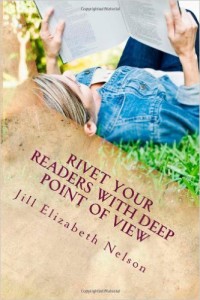 This booklet offers advice to writers about point of view. It defines POV as a “position” from which something is considered or evaluated (p.6). The author eventually explains that this “position” is not a spatial location (e.g., a camera placement in cinematography), but instead, the psychology of whichever character is telling the story at any given moment.
This booklet offers advice to writers about point of view. It defines POV as a “position” from which something is considered or evaluated (p.6). The author eventually explains that this “position” is not a spatial location (e.g., a camera placement in cinematography), but instead, the psychology of whichever character is telling the story at any given moment.
She downplays the psychology of the narrator and insists that POV refers only to fictional characters. On page 12 however she refers to the omniscient narrator as a character, which I’m not sure is correct.
Nelson dutifully distinguishes first-, second-, and third-person “points of view,” although those are structural devices and not quite the same thing as identification of which character’s psychology is telling the story. A third-person narrator can tell a story from the POV of several different characters.
Nelson helpfully connects POV to narrative distance, a crucial, if difficult concept for many writers. First-person POV is supposedly more intimate because the main character is directly accessible to the reader unlike a character described at arm’s length by some third-person narrator. That’s certainly true.
However, a third-person-close narrator can go far deeper into the head of a character than a first-person narrator can, since nobody really knows everything (or even very much) about themselves. So it’s an oversimplification to say that first-person is always more intimate. It can be very constraining and there should be a good reason to choose it.
Nelson confusingly demonstrates narrative distance with several examples of free indirect discourse (FID), a narrative technique that she doesn’t define or explain. For a good examination of FID and narrative distance in general, a writer might enjoy an article by David Jauss: https://www.awpwriter.org/magazine_media/writers_chronicle_view/1731/from_long_shots_to_x-rays_distance_point_of_view_in_fiction_writing, an excerpt from his excellent book, On Writing Fiction: Rethinking Conventional Wisdom About the Craft. Cincinatti, OH: Writers Digest Books, 2011.
For Nelson, “Deep” POV seems to mean FID. It also means use of the objective correlative, describing actions and scenery in the context of a character’s concerns, rather than from the abstract, ungrounded POV of an omniscient narrator. Writers who want more on this might like to see Robert Owen Butler’s 2005 book, “From Where You Dream.”
Nelson rightly cautions writers against devolving into internal monologue in pursuit of deep POV, but her own examples are almost all FID, which can become tedious when overused. At least she doesn’t blatantly name emotions and feelings as some contemporary authors do (e.g., Elena Ferrante in “The Days of Abandonment”).
There’s plenty of advice for any writer, presented as cautions against overuse of dialog tags, prepositions, passive voice, and so on.
The book would have been stronger if it had identified and explained the concept of free indirect discourse, a technique that has been around since Madame Bovary. That flaw aside, the collection of admonitions and examples do make up an entreaty to avoid abstraction and emphasize character psychology, good advice for any writer.
Nelson, Jill Elizabeth (2012), Rivet Your Readers with Deep Point of View. Self-published: www.jillelizabethnelson.com. (59 pp.)
